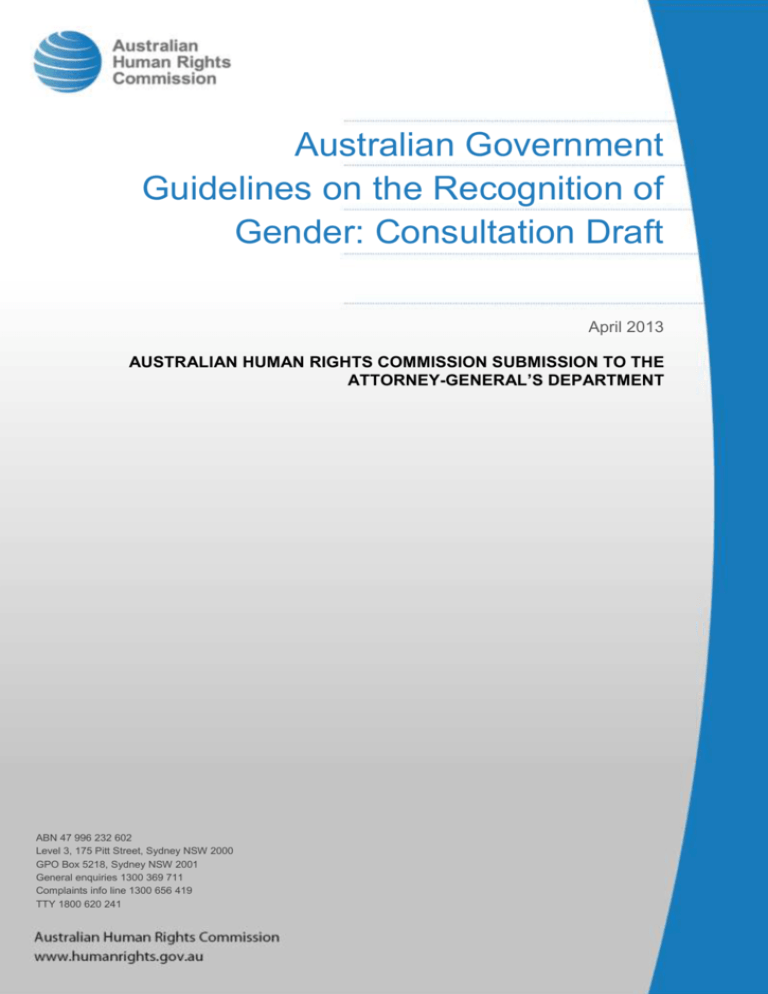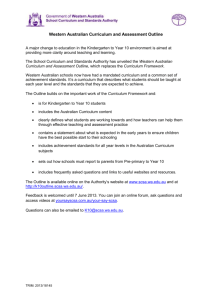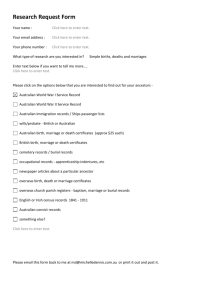
Australian Government
Guidelines on the Recognition of
Gender: Consultation Draft
April 2013
AUSTRALIAN HUMAN RIGHTS COMMISSION SUBMISSION TO THE
ATTORNEY-GENERAL’S DEPARTMENT
ABN 47 996 232 602
Level 3, 175 Pitt Street, Sydney NSW 2000
GPO Box 5218, Sydney NSW 2001
General enquiries 1300 369 711
Complaints info line 1300 656 419
TTY 1800 620 241
Australian Human Rights Commission
Submission to the Attorney-General’s Department – April 2013
Table of Contents
1
Introduction .......................................................................................................... 3
2
Summary ........................................................................................................ 3
3
Recommendations ......................................................................................... 4
4
The Sex Files Report ..................................................................................... 4
5
Human rights and the recognition of intersex and gender identity........... 5
6
The Guidelines ............................................................................................... 6
6.1
Sex and Gender Classification ............................................................................ 6
6.2
Proof of Sex and Gender ..................................................................................... 7
6.3
Collecting Sex and Gender Information ............................................................. 7
6.4
Queries and complaints ...................................................................................... 8
6.5
Implementation .................................................................................................... 8
2
Australian Human Rights Commission
Submission to the Attorney-General’s Department – April 2013
1
Introduction
The Australian Human Rights Commission makes this submission to the
Attorney-General’s Department consultation on the Australian
Government Guidelines on the Recognition of Sex and Gender
Consultation Draft (Guidelines).
The Guidelines are a response to the Commission’s Sex Files concluding
paper. The Commission commends the Australian Government for
introducing a reform which will make it easier for individuals to have their
sex and/or gender recognised by the Government. In conjunction with the
introduction of the Sex Discrimination Amendment (Sexual Orientation,
Gender Identity and Intersex Status) Bill 2013 (Cth) (SDA Bill), the
Guidelines represent an important step forward for people discriminated
against on the basis of their gender identity or because they are intersex.
2
Summary
In 2009 the Commission consulted on the legal recognition of sex and
gender in official documents and government records. The consultation
revealed that there are significant limitations in the way that official
documents and government records record sex and gender. The result of
the consultation was the Sex Files concluding paper which included 15
recommendations.
These recommendations included that the ‘federal government should
consider the development of national guidelines concerning the collection
of sex and gender information from individuals’.1 The Commission is
encouraged to see the Government develop the Guidelines in response
to this recommendation. The Commission supports the adoption of the
Guidelines.
The Commission also considers that the federal government should take
a strong leadership role in ensuring the processes and criteria throughout
Australia are consistent, streamlined and fair for people who wish to
change their legal sex or gender. The implementation of the
Commonwealth’s approach in the Guidelines will assist in this process.
The Commission strongly supports the Guidelines. In particular the
Commission is encouraged to see that the Guidelines:
provide for individuals to be recognised as neither male nor
female
do not require surgery as a criterion for being recognised as a
particular gender
do not include marital status as a criterion for changing gender
information on government records
provide for consistency across the Australian Government.
3
Australian Human Rights Commission
Submission to the Attorney-General’s Department – April 2013
The Commission encourages the Government to consider some further
options to strengthen the effectiveness and accessibility of the
Guidelines.
3
Recommendations
The Australian Human Rights Commission recommends that:
4
The Australian Government Guidelines on the Recognition of Gender
be adopted and enter into force by 1 July 2013 [Recommendation
1].
The Government use the Guidelines as a platform for developing a
nationally consistent approach to the legal recognition of sex and/or
gender with state and territory governments [Recommendation 2].
Individuals not be required to select a personal title which is
inconsistent with their sex or gender [Recommendation 3].
Evidence from Registered Psychologists certifying an individual’s sex
or gender should satisfy the requirements of the Guidelines
[Recommendation 4].
The Guidelines be more explicit on the legitimate reasons why
individuals
may
have
conflicting
records
of
gender
[Recommendation 5].
The Guidelines refer to the collection of sex and genderdisaggregated data in paragraph 24 and clarify that this data should
continue to be collected where it is necessary for the ongoing
monitoring of equality between men and women [Recommendation
6].
The Guidelines reference the Commission as a mechanism for
enquiries and complaints about gender identity and intersex
discrimination, subject to the passage of the SDA Bill
[Recommendation 7].
The Guidelines include a requirement for departments and agencies
to provide an implementation report after 18 months
[Recommendation 8].
The Guidelines include a requirement that departments and agencies
provide clear and accessible information on their website about how
sex and/or gender can be amended in government records and
documents [Recommendation 9].
The Sex Files Report
In 2009 the Commission consulted on the legal recognition of sex and
gender in official documents and government records. The consultation
4
Australian Human Rights Commission
Submission to the Attorney-General’s Department – April 2013
revealed that there are significant limitations in the way that official
documents and government records record sex and gender. The result of
the consultation was the Sex Files concluding paper which included 15
recommendations.
These recommendations included that the ‘federal government should
consider the development of national guidelines concerning the collection
of sex and gender information from individuals’.2 The Commission is
encouraged to see the Government develop the Guidelines in response
to this recommendation. The Commission supports their adoption.
The Commission recommends that the Australian Government
Guidelines on the Recognition of Gender be adopted and enter into
force by 1 July 2013 [Recommendation 1].
The Guidelines are consistent with the Government’s commitment in the
National Human Rights Action Plan 2012 (Action Plan).3 In the Action
Plan the Government also committed to ‘work with the states and
territories to develop a nationally consistent approach to legally changing
sex’.4 This is also in response to the Sex Files recommendations.5 The
Commission considers that the federal government should take a strong
leadership role in ensuring the processes and criteria throughout
Australia are consistent, streamlined and fair for people who wish to
change their legal sex. A national approach is necessary given the
complexities and inconsistencies across, and between, federal and state
and territory governments. The implementation of the Guidelines will
assist in this process.
The Commission recommends that the Government use the
Guidelines as a platform for developing a nationally consistent
approach to the legal recognition of sex and/or gender with state
and territory governments [Recommendation 2].
5
Human rights and the recognition of intersex and gender
identity
There is no separate international human rights agreement that deals
specifically with gender identity and intersex, however all people have
the same human rights regardless of their gender identity or because
they are intersex. The Commission outlines relevant human rights
standards in the Sex Files concluding paper.6
The Yogyakarta Principles provide specific guidance on how these
standards should be interpreted in relation to the protection of gender
identity.7 While not legally binding they are persuasive in shaping our
understanding of how existing binding human rights obligations apply
and relate to people who are sex and gender diverse.
In particular, Yogyakarta Principle 3 outlines the right to recognition
before the law for all people regardless of gender identity:
5
Australian Human Rights Commission
Submission to the Attorney-General’s Department – April 2013
Everyone has the right to recognition everywhere as a person before the law.
Persons of diverse sexual orientations and gender identities shall enjoy legal
capacity in all aspects of life. Each person’s self-defined sexual orientation and
gender identity is integral to their personality and is one of the most basic
aspects of self-determination, dignity and freedom. No one shall be forced to
undergo medical procedures, including sex reassignment surgery, sterilisation
or hormonal therapy, as a requirement for legal recognition of their gender
identity. No status, such as marriage or parenthood, may be invoked as such to
prevent the legal recognition of a person’s gender identity. No one shall be
subjected to pressure to conceal, suppress or deny their sexual orientation or
gender identity.
In addition, Yogyakarta Principle 3 details actions that countries such as
Australia should undertake to ensure they are not in breach of their
human rights obligations. These include taking all necessary legislative,
administrative and other measures to ensure that procedures exist
whereby all government-issued identity papers which indicate a person’s
gender/sex – including birth certificates, passports, electoral records and
other documents – reflect the person’s profound self-defined gender
identity. The Commission is encouraged to see the Government’s steps
in this regard.
6
The Guidelines
The Commission strongly supports the development of the Guidelines.
The Commission is particularly encouraged to see that the Guidelines:
provide for individuals to be recognised as neither male nor
female
do not require surgery as a criterion for being recognised as a
particular gender
do not include marital status as a criterion for changing gender
information on government records
provide for consistency across the Australian Government.
The Commission encourages the Government to consider some further
options to strengthen the effectiveness and accessibility of the
Guidelines.
6.1
Sex and Gender Classification
Most personal titles, such as Mr and Mrs, are gendered to correspond
with either ‘male’ or ‘female’. Given the option within the Guidelines to be
recognised as X (Intersex/Indeterminate/Unspecified), and that the
collection of sex/gender data is not always required, the Guidelines could
be amended to include guidance for departments and agencies that it
may not be appropriate to require individuals to select from a list of
possible titles which may be inconsistent with their sex or gender.
Instead, individuals could self-nominate a title or remain silent. This is
6
Australian Human Rights Commission
Submission to the Attorney-General’s Department – April 2013
particularly important in electronic forms which often includes ‘title’ as a
mandatory field.
The Commission recommends that individuals not be required to
select a personal title which is inconsistent with their sex or gender
[Recommendation 3].
6.2
Proof of Sex and Gender
In addition to registered medical practitioners, the Government should
give consideration to broadening the category of medical professionals
who are able to provide evidence certifying the sex and/or gender of an
applicant to include Registered Psychologists. This is because
psychological counselling concerning sex or gender identity should
satisfy the criteria for sex affirmation.8
Evidence from Registered Psychologists certifying an individual’s
sex or gender should satisfy the requirements of the Guidelines
[Recommendation 4].
As identified in the footnote to paragraph 21 of the Guidelines, there may
be legitimate reasons why people may hold a passport in a gender which
is different to that on other government records. This may be because of
safety reasons or because of difficulties posed with travelling across
borders.9 Particularly during the implementation phase of the Guidelines
it may be helpful to also include this point in the body of the Guidelines
as an education tool for public servants.
The Commission recommends that the Guidelines be more explicit
on the legitimate reasons why individuals may have conflicting
records of gender [Recommendation 5].
6.3
Collecting Sex and Gender Information
The Commission welcomes the specific recognition in the Guidelines that
collecting and maintaining gender-disaggregated data is crucial to the
ongoing monitoring of equality between men and women. This is
consistent with Australia’s obligations under the Convention on the
Elimination of All Forms of Discrimination against Women (CEDAW).
However the Guidelines should clarify that the data to be collected for
CEDAW purposes should be ‘sex and gender-disaggregated data’.
Further, as an educative tool for public servants the Guidelines should
clarify that departments and agencies should continue to collect this data
where it is necessary for the ongoing monitoring of equality between men
and women.
The Commission recommends that the Guidelines refer to the
collection of sex and gender-disaggregated data in paragraph 24
and clarify that this data should continue to be collected where it is
necessary for the ongoing monitoring of equality between men and
women [Recommendation 6].
7
Australian Human Rights Commission
Submission to the Attorney-General’s Department – April 2013
6.4
Queries and complaints
Subject to the passage of the SDA Bill the Guidelines could be amended
to refer to the Commission as a mechanism to accept enquiries or
complaints about alleged discrimination on the basis of gender identity or
intersex status under the SDA.
The Commission recommends that the Guidelines reference the
Commission as a mechanism for enquiries and complaints about
gender identity and intersex discrimination under the SDA, subject
to the passage of the SDA Bill [Recommendation 7].
6.5
Implementation
The Commission acknowledges that a certain period of time is necessary
for government departments and agencies to update policies and
systems to reflect the Guidelines. To ensure ongoing implementation
within departments and agencies, an implementation report to the
Attorney-General’s Department after 18 months may be beneficial.
The Commission recommends the Guidelines include a requirement
for departments and agencies to provide an implementation report
to the Attorney-General’s Department after 18 months
[Recommendation 8].
The Commission supports the Guidelines as a tool for standardising the
collection and recognition of sex and gender across government
departments and agencies, and as a tool for educating public servants.
In addition to this the Commission recommends that paragraph 40 be
expanded to specifically require these departments and agencies to
provide clear and accessible information to the public about how
individuals can amend their gender in government documents.10
The Commission recommends the Guidelines include a requirement
that departments and agencies provide clear and accessible
information on their website about how sex and/or gender can be
amended in government records and documents [Recommendation
9].
1
Australian Human Rights Commission, The sex and gender diversity project: Concluding paper
(2009), rec 10. At
http://www.humanrights.gov.au/sex-files-legal-recognition-concluding-paper-sex-and-gender-2009
(viewed 18 April 2013).
2 Australian Human Rights Commission, above.
3 Australian Government, National Human Rights Action Plan (2012), item 209. At
http://www.ag.gov.au/Consultations/Pages/NationalHumanRightsActionPlan.aspx (viewed 8 April
2013).
4 Australian Government, National Human Rights Action Plan, above, item 208.
5 Australian Human Rights Commission, note 1, rec 11.
8
Australian Human Rights Commission
Submission to the Attorney-General’s Department – April 2013
6
Australian Human Rights Commission, above, pp 11-12. Also see Australian Human Rights
Commission, Protection from discrimination on the basis of sexual orientation and sex and/or gender
identity (2011), pp 7-8. At
http://www.humanrights.gov.au/publications/consultation-protection-discrimination-basis-sexualorientation-and-sex-andor-gender (viewed 18 April 2013).
7 The Yogyakarta Principles: Principles on the application of international human rights law in relation
to sexual orientation and gender identity (2007). At http://www.ypinaction.org/ (viewed 22 April 2013).
8 See Australian Government, Australian Government Guidelines on the Recognition of Gender
(Consultation Draft) (2013), para 20. Also see Australian Human Rights Commission, note 1, p 31.
9 See for example Australian Human Rights Commission, above, s 8.2.
10 Also see Australian Government, The sex and gender diversity project: Concluding paper (2009),
rec 15. At
http://www.humanrights.gov.au/sex-files-legal-recognition-concluding-paper-sex-and-gender-2009
(viewed 18 April 2013).
9







